| |
|
Xiamen Oil Paintings, Wholesale Direct!
|
|
100% hand painted, 100% cotton canvas, 100% money back if not satisfaction. |
|
|
|
|
ART WORKS INDEX
A
B
C
D
E
F
G
H
I
J
K
L
M
N
O
P
Q
R
S
T
U
V
W
X
Y
Z
|
|
ARTISTS INDEX
A
B
C
D
E
F
G
H
I
J
K
L
M
N
O
P
Q
R
S
T
U
V
W
X
Y
Z
|
|
|
|
|
|
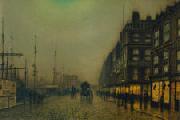 |
Atkinson Grimshaw
|
|
British
1836-1893
Atkinson Grimshaw Gallery
Grimshaw's primary influence was the Pre-Raphaelites. True to the Pre-Raphaelite style, he put forth landscapes of accurate color and lighting, and vivid detail. He often painted landscapes that typified seasons or a type of weather; city and suburban street scenes and moonlit views of the docks in London, Leeds, Liverpool, and Glasgow also figured largely in his art. By applying his skill in lighting effects, and unusually careful attention to detail, he was often capable of intricately describing a scene, while strongly conveying its mood. His "paintings of dampened gas-lit streets and misty waterfronts conveyed an eerie warmth as well as alienation in the urban scene."
Dulce Domum (1855), on whose reverse Grimshaw wrote, "mostly painted under great difficulties," captures the music portrayed in the piano player, entices the eye to meander through the richly decorated room, and to consider the still and silent young lady who is meanwhile listening. Grimshaw painted more interior scenes, especially in the 1870s, when he worked until the influence of James Tissot and the Aesthetic Movement.
On Hampstead Hill is considered one of Grimshaw's finest, exemplifying his skill with a variety of light sources, in capturing the mood of the passing of twilight into the onset of night. In his later career this use of twilight, and urban scenes under yellow light were highly popular, especially with his middle-class patrons.
His later work included imagined scenes from the Greek and Roman empires, and he also painted literary subjects from Longfellow and Tennyson ?? pictures including Elaine and The Lady of Shalott. (Grimshaw named all of his children after characters in Tennyson's poems.)
In the 1880s, Grimshaw maintained a London studio in Chelsea, not far from the comparable facility of James Abbott McNeill Whistler. After visiting Grimshaw, Whistler remarked that "I considered myself the inventor of Nocturnes until I saw Grimmy's moonlit pictures."[9] Unlike Whistler's Impressionistic night scenes, however, Grimshaw worked in a realistic vein: "sharply focused, almost photographic," his pictures innovated in applying the tradition of rural moonlight images to the Victorian city, recording "the rain and mist, the puddles and smoky fog of late Victorian industrial England with great poetry."
Some artists of Grimshaw's period, both famous and obscure, generated rich documentary records; Vincent Van Gogh and James Smetham are good examples. Others, like Edward Pritchett, left nothing. Grimshaw left behind him no letters, journals, or papers; scholars and critics have little material on which to base their understanding of his life and career.
Grimshaw died 13 October 1893, and is buried in Woodhouse cemetery, Leeds. His reputation rested, and his legacy is probably based on, his townscapes. The second half of the twentieth century saw a major revival of interest in Grimshaw's work, with several important exhibits of his canon.
|
|
|
|
 |
AST, Balthasar van der
|
|
Dutch Baroque Era Painter, ca.1593-1656
1657). Dutch painter. He was the brother-in-law of Ambrosius Bosschaert (i), whose household he entered in 1609, after the death of his father. He remained as Bosschaert's pupil, until he was 21. In 1615 van der Ast moved with the Bosschaert family to Bergen-op-Zoom. However, a year later the Bosschaerts were living in Utrecht, but van der Ast is not recorded there until 1619, when he was entered as a master in the Guild of St Luke. He remained in Utrecht until 1632, then lived in Delft, where he enrolled in the painters' guild on 22 June 1632. On 26 February 1633 he married Margrieta Jans van Bueren in Delft, where he spent the rest of his career; the marriage produced two children.
|
|
|
|
|
|
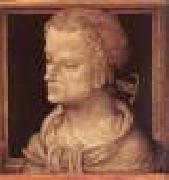 |
ASPERTINI, Amico
|
|
Italian Painter, ca.1474-1552
He was born in Bologna to a family of painters (Guido Aspertini and Giovanni Antonio Aspertini, his father), and studied under masters such as Lorenzo Costa and Francesco Francia. He is briefly documented in Rome between 1500-1503, returning to Bologna and painting in a style influenced by Pinturicchio. In Bologna in 1504, he joined Francia and Costa in painting frescoes for the newly restored Oratory of Santa Cecilia in San Giacomo Maggiore, a work commissioned by Giovanni II Bentivoglio.
In 1507-09, he painted a fresco cycle in San Frediano in Lucca. Asperini painted in 1508-1509 the splendid frescoes in the Chapel of the Cross in the Basilica di San Frediano in Lucca. Aspertini was also one of two artists chosen to decorate a triumphal arch for the entry into Bologna of Pope Clement VII and Emperor Charles V in 1529.
He died in Bologna.
Giorgio Vasari describes Aspertini as having an eccentric personality, who, half-insane, worked so rapidly with both hands that chiaroscuro was split, chiaro in one hand, scuro in the other. He quotes Aspertini as complaining that all other Bolognese colleagues were copying Raphael. Aspertini also painted façade decorations (all lost), and altarpieces, many of which are often eccentric and charged in expression. For example, his Bolognese Pieta appears to occur in an other-worldy electric sky.
|
|
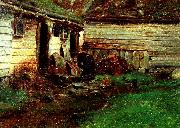 |
askevold
|
|
Anders Monsen Askevold was born in Askvoll, Norway in 1834. His early training started at the age of thirteen in Bergen under Hans Leganger Reuch. He trained in Dusseldorf under Professor Hans Gude from 1855 until 1859. and he is known as a member of the Dusseldorf school with others like Adelsteen Normann.
From 1861 to 1866 he was in Paris. After this he moved back to Dusseldorf where he would spend his winters in Germany and his summers in Norway.
Askevold did some commissions for churches in Norway. He died in 1900 in Dusseldorf.
|
|
|
|
 |
Asher Brown Durand
|
|
1796-1886
Asher Brown Durand Galleries
His interest shifted from engraving to oil painting around 1830 with the encouragement of his patron, Luman Reed. In 1837, he accompanied his friend Thomas Cole on a sketching expedition to Schroon Lake in the Adirondacks and soon after he began to concentrate on landscape painting. He spent summers sketching in the Catskills, Adirondacks, and the White Mountains of New Hampshire, making hundreds of drawings and oil sketches that were later incorporated into finished academy pieces which helped to define the Hudson River School.
Durand is particularly remembered for his detailed portrayals of trees, rocks, and foliage. He was an advocate for drawing directly from nature with as much realism as possible. Durand wrote, "Let [the artist] scrupulously accept whatever [nature] presents him until he shall, in a degree, have become intimate with her infinity...never let him profane her sacredness by a willful departure from truth."
Like other Hudson River School artists, Durand also believed that nature was an ineffable manifestation of God. He expressed this sentiment and his general views on art in his "Letters on Landscape Painting" in The Crayon, a mid-19th century New York art periodical. Wrote Durand, "[T]he true province of Landscape Art is the representation of the work of God in the visible creation..."
Durand is noted for his 1849 painting Kindred Spirits which shows fellow Hudson River School artist Thomas Cole and poet William Cullen Bryant in a Catskills landscape. This was painted as a tribute to Cole upon his death in 1848. The painting, donated by Bryant's daughter Julia to the New York Public Library in 1904, was sold by the library through Sotheby's at an auction in May 2005 to Alice Walton for a purported $35 million. The sale was conducted as a sealed, first bid auction, so the actual sales price is not known. At $35 million, however, it would be a record price paid for an American painting at the time.
|
|
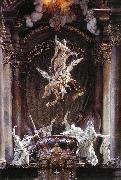 |
ASAM, Egid Quirin
|
|
German Baroque Era Sculptor, 1692-1750
Sculptor, stuccoist, painter and architect, son of Hans Georg Asam. After working with his father, he was apprenticed to Anton Faistenberger in Munich to learn sculpture. He presumably accompanied his brother Cosmas Damian Asam to Rome (1711-13), where he studied works by Bernini. In 1724 he became a valet and court stuccoist to the Prince-Bishop of Freising and in 1730 a valet to the Elector of Bavaria.
|
|
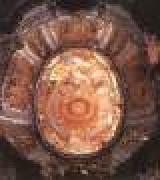 |
ASAM, Cosmas Damian
|
|
German Baroque Era Sculptor, 1686-1739
Bavarian architects and decorators. After studying in Rome (1711 ?C 13), Cosmas Damian became a prolific fresco painter, and his brother, Egid Quirin, became a sculptor and stuccoist. They developed the effects of dramatic lighting and illusionism originated by Gian Lorenzo Bernini and Andrea Pozzo. Working as a team, they produced magnificent illusionistic decoration in ecclesiastical buildings, combining dramatic lighting and colour. Their works are notable for their profound and dramatic intensity of religious feeling. The brothers became the principal late Baroque exponents of illusionist decoration in religious architecture. Their most notable collaboration is the church of St. John Nepomuk in Munich (1733 ?C 46) ?? known as the Asamkirche in honour of the brothers.
|
|
 |
Ary Scheffer
|
|
Dordrecht 1795-Argenteuil 1858
Dutch painter, sculptor and lithographer, active in France. He became a French citizen in 1850. He received his earliest training in the studio of his parents, Johann-Bernhard Scheffer (1764-1809) and Cornelia Scheffer (1769-1839), who were both artists, as was his brother Henri Scheffer (1798-1862). He then attended the Amsterdam Teeken-Academie (1806-9). At the first Exhibition of Living Masters in Amsterdam in 1808 he showed Hannibal Swearing to Avenge the Death of his Brother Hasdrubal
|
|
 |
Ary de Vois
|
|
was a Dutch Golden Age painter.
Ary de Vois was the son of Alewijn de Vois from Utrecht, who was organist in the Pieterskerk, Leiden, in 1635. Ary became a pupil in Utrecht of Nikolaus Knepfer, who also taught Jan Steen. Ary then returned to Leiden to study with Abraham van den Tempel, who lived there between 1648 and 1660. De Vois joined the Leiden Guild of St Luke on 16 October 1653, paying dues until 1677. He was dean in 1662-64, headman in 1664-65 and dean again from 1667-68. He married Maria van der Vecht, on 5 February 1656.
According to Houbraken his marriage caused a lull in his production, especially when he moved to Warmond where he took up fishing as a hobby. He had to move back to Leiden in order to keep his production levels high
|
|
 |
Arvid Johanson
|
|
(born 3 February 1929) was a Norwegian newspaper editor and politician for the Labour Party. He served five full terms in the Parliament of Norway, was Norway's second Minister of Petroleum and Energy, and outside of politics he spent most of his career in the newspaper Halden Arbeiderblad.
He was born in Halden as a son of Arvid Martin Johanson (1896 - 1981) and housewife Karla Niemi (1899 - 1932). He started his career as a journalist in Halden Arbeiderblad in 1947, and remained there for a year. In 1949 he worked in Sarpsborg Arbeiderblad. He returned to Halden Arbeiderblad, and remained there for the rest of his career. He underwent studies at the Norwegian Journalist Academy from 1942 to 1953 and at Fircroft College from 1954 to 1955. He was a board member of the county chapter of the Norwegian Press Association from 1954 to 1955.
|
|
|
|
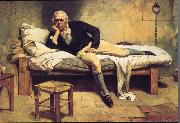 |
Arturo Michelena
|
|
16 June 1863 - 29 July 1898) was a Venezuelan painter born in Valencia, Carabobo State. He began to paint at a young age under his father's tutelage. Traveled to Paris where he studied in the famous Academie Julian. He was the first Venezuelan artist to succeed overseas and, with Cristebal Rojas (1857-1890) and Marten Tovar y Tovar (1827-1902), one of the most important Venezuelan painters of the 19th century.
His first great success occurred in Paris at Le Salon des Artistes Français in 1887. Encouraged by his teacher Jean-Paul Laurens (1838-1921), Michelena presented a canvas titled L'Enfant Malade (The sick boy) which was awarded the Gold Medal, second class, the highest honor a foreign artist could receive at the salon. The painting was quickly considered a masterpiece and was acquired by the Astors in New York in the late 19th century. Later the painting traveled to South Florida when it was acquired by Owens Burns, a business partner of John Ringling, the circus magnate. After Burns' death the painting was stored in the Ringling Museum's vaults where it remained away from public view for more than 60 years. In 2004 Sotheby's rescued the canvas and arranged for it to be included in an auction of Latin American art.
|
|
 |
Arturo Ferrari
|
|
(Milan, 1861 - 1932) was an Italian painter.
Initiated into artistic studies by his father Cesare, an associate of Luigi Scrosati, and the painter Mose Bianchi from Lodi, Arturo Ferrari completed his training at the Brera Academy under the guidance of Giuseppe Bertini from 1877 to 1884 while working in the studio of Gerolamo Induno at the same time. He made his debut at the Esposizione di Belle Arti di Brera in 1879 with a view of the interior of Milan Cathedral, thus inaugurating the repertoire of Milanese perspective views that was to be a constant feature of his vast production of oil paintings and watercolours. He soon became the guiding spirit of a poetic and sentimental evocation of "Old Milan" during the phase of transition to the 20th century, when the face of the city changed radically through wholesale rebuilding. A regular participant in all the major exhibitions until 1932, the year of his death, he was the recipient of numerous marks of official recognition and enjoyed considerable success with the public as well as the esteem of conservative critics.
|
|
|
|
|
|
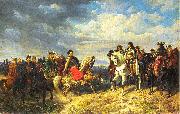 |
Artur Grottger
|
|
(1837 - 1867) was a Polish painter and graphic designer, one of the most prominent artists of the early 1800s despite his brief life.
He was born in Eastern Galicia to an amateur artist of German background, Jan Jozef Grottger, and a Polish mother. Grottger studied painting under the apprenticeships of Jan Kanty Maszkowski and Juliusz Kossak in Lwew. Grottger received an imperial scholarship to attend the Krakow School of Fine Arts, where he studied under Władysław Łuszczkiewicz and Wojciech Kornel Stattler. Around this time he met one of his biggest future art patrons and benefactors, Aleksander Pappenheim.
Grottger painted mostly epic battle scenes. He moved to Vienna in 1854, where he produced some of his most famous paintings. In 1865, Grottger returned to Poland and stayed in Krakew and Lwew, but left this time for good in 1866.
|
|
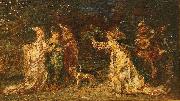 |
Artist Adolphe Joseph Thomas Monticelli
|
|
(October 14, 1824 - June 29, 1886) was a French painter of the generation preceding the Impressionists.
Monticelli was born in Marseille in humble circumstances. He attended the École Municipale de Dessin in Marseille from 1842 to 1846, and continued his artistic training in Paris, where he studied under Paul Delaroche at the École des Beaux-Arts. In Paris he made copies after the Old Masters in the Louvre, and admired the oil sketches of Eugene Delacroix. In 1855 he met Narcisse Diaz, a member of the Barbizon school, and the two often painted together in the Fontainebleau Forest. Monticelli frequently adopted Diaz's practice of introducing nudes or elegantly costumed figures into his landscapes.
He developed a highly individual Romantic style of painting, in which richly colored, dappled, textured and glazed surfaces produce a scintillating effect. He painted courtly subjects inspired by Antoine Watteau; he also painted still lives, portraits, and Orientalist subjects that owe much to the example of Delacroix.
After 1870, Monticelli returned to Marseille, where he would live in poverty despite a prolific output, selling his paintings for small sums. An unworldly man, he dedicated himself singlemindedly to his art.
The young Paul Cezanne had befriended Monticelli in the 1860s, and the influence of the older painter's work can be seen in Cezanne's work of that decade. Between 1878 and 1884 the two artists often painted landscapes together, once spending a month roaming the Aix countryside. Although Monticelli experimented briefly around 1870 with a treatment of light reflecting the discoveries of the Impressionists, he found the objectivity of this approach uncongenial.
Confronted with criticism of his style of painting Monticelli himself remarked, "I paint for thirty years from now". The work of this instinctive painter reached its greatest spontaneity in the decade before his death in 1886.
|
|
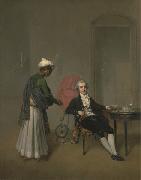 |
Arthur William Devis
|
|
(10 August 1762 - 11 February 1822) was an English painter of history paintings and portraits. He was appointed draughtsman in a voyage projected by the East India Company in 1783, under Captain Henry Wilson, in which he was wrecked on the Pelew Islands before proceeding to Canton and thence to Bengal. He painted portraits and historical subjects, sixty-five of which he exhibited (1779-1821) at the Royal Academy.
|
|
|
|
 |
Arthur streeton
|
|
1867 - 1943
Australian painter. He moved to Melbourne with his family when he was seven. In 1882 he enrolled as a student of drawing at the evening classes of the National Gallery School of Design and briefly in the School of Painting, but he had no sustained formal instruction in painting. At the same time he began making watercolour sketches of Melbourne, and by 1886 his skill led to an apprenticeship as a lithographer to George Troedel and Co. of Collins Street. The most important early influence on Streeton was Tom Roberts, who had returned to Melbourne from Europe in 1885. With Frederick McCubbin, Streeton and Roberts painted en plein air at a temporary camp at Box Hill, forming what became known as the HEIDELBERG SCHOOL. A little later Streeton established the first permanent artists' camp at Eaglemont, north-west of Melbourne, overlooking the Yarra Valley, where he painted some of his most memorable works. 'Still glides the stream and shall forever glide'
|
|
 |
Arthur Quartley
|
|
(May 24, 1839 - May 19, 1886), was an American painter known for his marine seascapes.
Quartley was born in Paris and lived there to the age of twelve, when his family moved to Baltimore, Maryland. He studied drawing with his father C.G. Quartley, who was an English engraver. His father was reputed to have demanded two drawings per week from the young lad. At age 17, Arthur was apprenticed to a sign painter in Baltimore.
In 1862 Quartley and his family founded a design firm in Baltimore. The firm Emmart & Quartley was regarded as the best decorating company in the city (Dictionary of American Biography); however, young Quartley began painting marine seascapes of Chesapeake Bay, and progressively spent more and more time in that pursuit. He held a successful show of marine paintings at the studio of Norval H. Busey in Baltimore. Scholar Elizabeth Johns remarked that Quartley's work reveals familiarity with the Dutch Masters marine tradition of composition in treatment of light and color.
To pursue his painting more seriously, Quartley moved to New York City in 1875. New York at that time had become a premier center for notable painters. From there he painted seascapes of Long Island bays, New York Harbor, the New Hampshire Isle of Shoals, and Naragansett Bay in Rhode Island.
The Hudson River School was waning at this point, so that other groups were forming, among them the Tilers, of whom Quartley was a founding member. The Tilers was a group of artists and writers, that included such luminaries as Winslow Homer, William Merritt Chase, and Augustus Saint Gaudens. They met frequently to exchange ideas and decorate ceramic tiles in promotion of their works. They also took excursions for painting, such as the 1878 pilgrimage to Eastern Long Island by Quartley and ten others. On that trip Quartley painted Seascape and also a blue painted tile of an introspective girl at the beach. The journalist and philanthropist John W. McCoy promoted the careers of Quartley and of his friend, the sculptor William H. Rinehart.
|
|
 |
Arthur Pond
|
|
Arthur Pond (1705?-1758) was an English painter and engraver.
Born about 1705, was educated in London, and stayed for a time in Rome studying art, in company with the sculptor Roubiliac. He became a successful portrait-painter.
He was elected a Fellow of the Royal Society in 1752, and died in Great Queen Street, Lincoln's Inn Fields, 9 September 1758.
His numerous original portraits include Alexander Pope, William, Duke of Cumberland, and Peg Woffington. Pond was also a prolific etcher, and used various mixed processes of engraving by means of which he imitated or reproduced the works of masters such as Rembrandt, Raphael, Salvator Rosa, Parmigiano, Caravaggio, and the Poussins.
In 1734-5 he published a series of his plates under the title Imitations of the Italian Masters. He also collaborated with George Knapton in the publication of the Heads of Illustrious Persons, after Jacobus Houbraken and George Vertue, with lives by Thomas Birch (London, 1743-52); and engraved sixty-eight plates for a collection of ninety-five reproductions from drawings by famous masters, in which Knapton was again his colleague. Another of his productions was a series of twenty-five caricatures after Pier Leone Ghezzi, republished in 1823 and 1832 as Eccentric Characters.
|
|
|
|
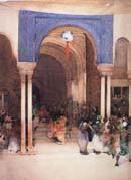 |
Arthur Melville
|
|
British Painter, 1858-1904, Scottish painter. He was trained in Edinburgh under James Campbell Noble (1846-1913) and at the Royal Scottish Academy Schools. His early works are peasant subjects in a subdued tonal style. While at the Acad?mie Julian in Paris and at Grez-sur-Loing (1878-81) he developed a colouristic watercolour style with strong chiaroscuro. This was consolidated during his journey in 1881 to Egypt and Constantinople, and on trips between 1890 and 1893 to Spain (with Frank Brangwyn) and North Africa. Contrasts of strong sunlight and coloured shadows were created in his 'blottesque' technique of colour droplets on paper saturated with Chinese white: sponge and brushwork were used to clarify form, as in Little Bullfight: 'Bravo Toro' (c. 1888-9; London, V&A). He was associated with the Glasgow Boys and influenced their development of colour and design. His closest contact with them came during outdoor sketching trips in Scotland between 1882 and 1889, and in Paris in 1886 and 1889. In 1886 he became an Associate of the Royal Scottish Academy and developed a strongly decorative oil style, seen in Audrey and her Goats (1884-9; London, Tate).
|
|
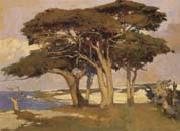 |
Arthur Mathews
|
|
an American Tonalist painter who was one of the founders of the American Arts and Crafts movement
1860-1945
|
|
|
|
 |
Arthur Loureiro
|
|
Australian, 1853-1932,Portuguese painter. He was a naturalist painter. His early training was at the Academia de Belas-Artes, Oporto, and in 1876 he went to Rome where he became a pupil of Francisco Pradilla Ortiz. In Italy he devoted himself to landscape painting. He exhibited in Paris at the Exposition Universelle (1878) and in the Sociedade Promotora de Belas-Artes in Lisbon (1880). In 1879 he was given a scholarship to go to Paris, where he stayed from 1880 to 1883.
|
|
|
|
 |
Arthur Hughes
|
|
1832-1915
British
Arthur Hughes Gallery
Hughes was born in London. His best-known paintings are April Love and The Long Engagement, both of which depict troubled couples contemplating the transience of love and beauty. They were inspired by John Everett Millais's earlier "couple" paintings but place far greater emphasis on the pathos of human inability to maintain the freshness of youthful feeling in comparison to the regenerative power of nature.
Like Millais, Hughes also painted an Ophelia and illustrated Keats's poem The Eve of St. Agnes. Hughes's version of the latter is in the form of a secular triptych, a technique he repeated for scenes from Shakespeare's As You Like It.
His works are noted for their magical, glowing colouring and delicate draughtsmanship.
Hughes was in close contact with the writer George MacDonald and illustrated some of his books as well as producing numerous illustrations for Norman MacLeod's monthly magazine, Good Words.
Hughes died in Kew Green, London, leaving about 700 known paintings and drawings, along with over 750 book illustrations.
|
|
 |
Arthur hacker,R.A.
|
|
1858-1919
was an English classicist painter. Born in London in 1858, Hacker was the son of Edward Hacker, a line engraver specialising in animal and sporting prints (who was also for many years the official Registrar of Births, Marriages and Deaths for Kentish Town in the St Pancras registration district, north London). In his art he was most known for painting religious scenes and portraits, and his art was also influenced by his extensive travels in Spain and North Africa. He studied at the Royal Academy between 1867 and 1880, and at the Atelier Bonnat in Paris. He was twice exhibited at the Royal Academy, in 1878 and 1910, and was elected an Academician in 1910. In 1894 he was the subject of a bust by Edward Onslow Ford. An original portrait by Hacker of Sir Alfred Keogh by hangs in the RAMC HQ Mess at Millbank, London. He died in London on November 12, 1919. In 1902,
|
|
 |
Arthur Fitzwilliam Tait
|
|
(February 5, 1819 -April 28, 1905) was an American artist who is known mostly for his paintings of wildlife. During most of his career, he was associated with the New York City art scene.
Tait was born in Lively Hall near Liverpool, England. At eight years old, because his father went bankrupt he was sent to live with relatives in Lancaster. It is during that time that he became attached to animals. Later on, in Manchester, England, Agnew & Zanetti Repository of Art acquired Arthur Tait who began self-learning to paint, as a twelve-year-old boy.
|
|
|
|
|
|
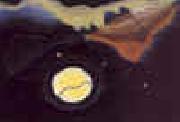 |
Arthur Dove
|
|
American
1880-1946
Dove returned to America in 1909 and met Alfred Stieglitz. Stieglitz, the eldest child of a New York rich family and was send to study in Germany at the age of 16 where he was overtaken with the passion of photography. In 1905 he returned to New York with 15 years of experience he was at the front lines to make photography respected as one of the fine art. Alfred Stieglitz was a well known photographer and gallery owner who was very active in promoting modern art in America. In his attempt to educate the art public, he started to introduce other art besides photography. Along with American modernists he would show European work. These pieces had never been seen in the United States.[1] Stieglitz was a New York art world celebrity.[1] Dove made the decision to quit his career as an illustrator but was in need of artistic identity along with emotional bolstering and Stieglitz filled both.[5] The photographer was 61, 16 years younger than Dove and with Anglo-Saxon heritage, being Protestant with a small town background was in contrast to Stieglitz??s experience being urban, Jewish and rooted in European culture. Dove was gentle, quite, and a good friend while Stieglitz was argumentative and shrewd. They both had in common that they believed art forms should embody modern spiritual values not materialism and tradition. Stieglitz was later the husband of the famed painter Georgia O??Keeffe. With Stiegliz??s support, Dove produced what are known as the first purely abstract paintings to come out of America. Dove exhibited his works at Stieglitz??s ??291?? gallery in 1910 and in 1912 when he had his first one-man exhibition. The 1910 show ??Younger American Painters?? put Dove in the company of his old friend Maurer. Dove showed one painting, a large still life painted in France ??The Lobster??, which would be his last representational work. The 1912 show at the ??291??, Doves only one man showed a group of pastels that came to be know as ??Ten Commandments??, would be the first public display of nonillusionistic art by an American. In the two years since meeting Stieglitz Dove found himself as a leader in international art developments. From 1912 to 1946 Dove showed his work yearly at Stieglitz??s galleries, ??291??, ??intimate Gallery?? and ??An American Place.?? Dove??s works were based in natural forms and he referred to his form of abstraction as ??extraction,?? in essence, extracting the essential forms of a scene from a nature.
|
|
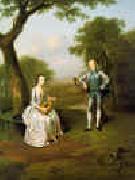 |
Arthur Devis
|
|
1712-1787
English
By 1728 he had left Preston, and the following year he was working in London for the Flemish topographical and sporting painter Peter Tillemans. There he specialized in landscape painting and copying various works in Tillemans studio after Marco Ricci, Giovanni Paolo Panini and Jan van Bloemen. Devis earliest known commission, Hoghton Towers from Duxon Hill, Lancashire (1735; priv. col., see 1983 exh. cat., no. 3), painted for Sir Henry Hoghton during a trip to Preston in 1734-5, shows Tillemans influence in its attention to detail and the use of thin, transparent paint. Thomas Lister with his Family (c. 1738; Chicago, IL, A. Inst.) demonstrates a similar interest in landscape, featuring the family group in Gisburn Park, Lancs. Devis had returned to London by 1742 and established himself as a painter of conversation pieces, with a studio in Great Queen Street. Roger Hesketh with his Family is typical of his work at this time; it shows how Devis transformed the intimacy of a Dutch 17th-century genre scene into an elegant interior with the group of sitters connected by formal, schematic gestures. Roger Hesketh stands apart, in a tastefully contrived pose, his legs crossed and right arm thrust inside his waistcoat. His son, Fleetwood, stands with his hand resting on a dog next to his wife, who is seated with an infant on her lap. The adjacent telescope, globe and marine paintings are intended to advertise Hesketh interest in astronomy and travel.
|
|
|
|
 |
Arthur Boyd Houghton
|
|
English Painter and Illustrator , 1836-1875
His work was varied and was revered during the mid-19th century. He traveled to America and Russia, creating illustrations for The Graphic and for numerous books, including The Arabian Nights and Don Quixote. His work was strongly influenced by the Pre-Raphaelite Brotherhood. Paul Hogath wrote a biography, published in 1981 by Gordon Fraser Work by this artist is held within various public collections incluiding Tate Britain in London, as well as a number of private collections around the world. Houghton is best known for etchings but also produced a number of oil paintings, many of his wife and children. He also wrote a little poetry which was published in his lifetime.
|
|
 |
Arthur Bowen Davies
|
|
1862-1928
Arthur Bowen Davies Gallery
Arthur Bowen Davies (September 26, 1863 ?C October 24, 1928) was an avant-garde American artist.
He was born in Utica, New York and studied at the Chicago Academy of Design from 1879 to 1882. He briefly attended the Art Institute of Chicago and then moved to New York City where he studied at the Art Students League.
Davies was a principal organizer of the 1913 Armory Show and was a member of The Eight, a group of painters including five associated with the Ashcan school: William Glackens (1870-1938), Robert Henri (1865-1929), George Luks (1867-1933), Everett Shinn (1876-1953) and John French Sloan (1871-1951), along with Arthur B. Davies (1862-1928), Ernest Lawson (1873-1939) and Maurice Prendergast (1859-1924). Davies is best known for his ethereal figure paintings. He worked as a billboard painter, engineering draftsman, and magazine illustrator.
|
|
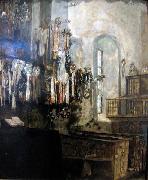 |
Arthur Ahnert
|
|
painted Interior of Wilhelmshausen church in 1898/1899.
|
|
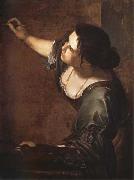 |
Artemisia gentileschi
|
|
1593-1652
was an Italian Early Baroque painter, today considered one of the most accomplished painters in the generation influenced by Caravaggio. In an era when women painters were not easily accepted by the artistic community, she was the first female painter to become a member of the Accademia di Arte del Disegno in Florence. She was one of the first female artists to paint historical and religious paintings, at a time when such heroic themes were considered beyond a woman's reach. Artemisia Gentileschi was born in Rome, July 8, 1593, the first child of the Tuscan painter Orazio Gentileschi, one of the best representatives of the school of Caravaggio. Artemisia was introduced to painting in her father's workshop, showing much more talent than her brothers, who worked alongside her. She learned drawing, how to mix color and how to paint. Since her father's style took inspiration from Caravaggio during that period, her style was just as heavily influenced in turn. But her approach to subject matter was different from her father's, as her paintings are highly naturalistic, where Orazio's are idealized. The first work of the young 17-year-old Artemisia (even if many at the time suspected that she was helped by her father) was the Susanna e i Vecchioni (Susanna and the Elders) (1610, Schönborn collection in Pommersfelden). The picture shows how Artemisia assimilated the realism of Caravaggio without being indifferent to the language of the Bologna school (which had Annibale Carracci among its major artists). It is one of the few Susanna paintings showing the two men planning their sexual harassment. It is likely that Artemisia had been sexually harrassed and painted Susanna as a reflection. In 1612, despite her early talent, Artemisia was denied access to the all-male professional academies for art. At the time, her father was working with Agostino Tassi to decorate the vaults of Casino della Rose inside the Pallavicini Rospigliosi Palace in Rome, so Orazio hired the painter to tutor his daughter privately. During this tutelage, Tassi raped Artemisia. Another man, Cosimo Quorlis had helped Tassi with the rape. After the initial rape, Artemisia continued to have sexual relations with Tassi, with the expectation that they were going to be married. However, Tassi reneged on his promise to marry Artemisia after he heard the rumor that she was having an affair with another man. Quorlis had threatened that if he could not have her, he would publicly humiliate her. Orazio pressed charges against Tassi only after he learned that Artemisia and Tassi were not going to be married. Orazio also claimed that Tassi stole a painting of Judith from the Gentileschi household. The major issue of this trial was the fact that Tassi had deflowered Artemisia. If Artemisia had not been a virgin before Tassi raped her, the Gentileschis would not be able to press charges. In the ensuing 7-month trial, it was discovered that Tassi had planned to murder his wife, had enjoined in adultery with his sister-in-law and planned to steal some of Orazio??s paintings. During the trial Artemisia was given a gynecological examination and was tortured using a device made of thongs wrapped around the fingers and tightened by degrees ?? a particularly cruel torture to a painter. Both procedures were used to corroborate the truth of her allegation, the torture device used due to the belief that if a person can tell the same story under torture as without it, the story must be true. At the end of the trial Tassi was imprisoned for one year. The trial has subsequently influenced the feminist view of Artemisia Gentileschi during the late 20th century. The painting Giuditta che decapita Oloferne (Judith beheading Holofernes) (1612 - 1613), displayed in the Capodimonte Museum of Naples, is impressive for the violence portrayed, and has been interpreted as a wish for psychological revenge for the violence Artemisia had suffered. One month after the trial, in order to restore her honor, Orazio arranged for his daughter to marry Pierantonio Stiattesi, a modest artist from Florence. Shortly afterwards the couple moved to Florence, where Artemisia received a commission for a painting at Casa Buonarroti and became a successful court painter, enjoying the patronage of the Medici family and Charles I. It has been proposed that during this period Artemisia also painted the Madonna col Bambino (The Virgin and Child), currently in the Spada Gallery, Rome. While in Florence,
|
|
 |
Artemisia Gentileschi
|
|
Italian
1593-1652
Artemisia Gentileschi Gallery
Gentileschi was born on July 8, 1593 in Rome. She was the daughter of the painter Orazio Gentileschi and was trained by him. Our perception of Gentileschi has been colored by the legend surrounding her. Her alleged rape by her father colleague, the quadratura painter Agostino Tassi, when she was 17, was the subject of a protracted legal action brought by Orazio in 1611. Although she was subsequently married off to Pietro Antonio di Vicenzo Stiattesi in 1612 and gave birth to at least one daughter, she soon separated from her husband and led a strikingly independent life for a woman of her time - even if there is no firm evidence for the reputation she enjoyed in the 18th century as a sexual libertine. After her marriage, Gentileschi lived in Florence until about 1620. She then worked in Genoa and settled in Naples in 1630. Gentileschi traveled to England in 1638-40, where she collaborated with her father on a series of canvasses for the Queen House, Greenwich (now Marlborough House, London). Gentileschi died in Naples in 1652.
It is tempting to adduce the established biographical data in partial explanation of the context of her art: the sympathy and vigor with which she evokes her heroines and their predicaments, and her obsession with that tale of female triumph, Judith and Holofernes. But such possibilities should not distract attention from the high professional standards that Gentileschi brought to her art. In a letter, dated July 3, 1612, to the Grand Duchess of Tuscany, Orazio claimed that "Artemisia, having turned herself to the profession of painting, has in three years so reached the point that I can venture to say that today she has no peer. Despite the obvious exaggeration, one can agree that Gentileschi art was of a consistently high quality virtually from the beginning.
|
|
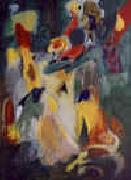 |
Arshile Gorky
|
|
Armenian
1904-1948
Arshile Gorky Gallery
Gorky was born in the village of Khorkom near Van, Turkey. It is not known exactly when he was born: it was sometime between 1902 and 1905. (In later years Gorky was vague about even the date of his birth, changing it from year to year.) In 1910 his father emigrated to America to avoid the draft, leaving his family behind in the town of Van. Gorky fled Van in 1915 during the Armenian Genocide and escaped with his mother and his three sisters into Russian-controlled territory. In the aftermath of the genocide, Gorky's mother died of starvation in Yerevan in 1919. Gorky was reunited with his father when he arrived in America in 1920, aged 16, but they never grew close. At age 31, Gorky married. He changed his name to Arshile Gorky, in the process reinventing his identity (he even told people he was a relative of the Russian writer Maxim Gorky).
In 1922, Gorky enrolled in the New School of Design in Boston, eventually becoming a part-time instructor. During the early 1920s he was influenced by impressionism, although later in the decade he produced works that were more postimpressionist. During this time he was living in New York and was influenced by Paul Cezanne. In 1927, Gorky met Ethel Kremer Schwabacher and developed a life lasting friendship. Schwabacher was his first biographer.
|
|
|
|
|
|
 |
Arnoldus Bloemers
|
|
born at Amsterdam in 1792, painted flowers, fruit, and animals. He was instructed by Antonie Piera, but principally imitated Van Huijsum. He died at the Hague in 1844. The Rotterdam Gallery has a flower-piece by him.
|
|
|
|
|
|
|
|
|
| Wholesale China Oil Painting Wholesale Oil Painting China Xiamen Portrait Reproduction on canvas Chinese Oil Painting Wholesale USA Oil Painting |
|
|
|
|
|